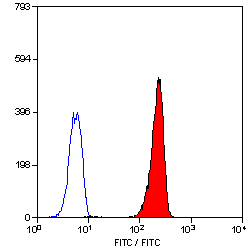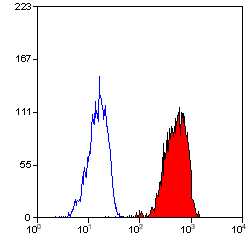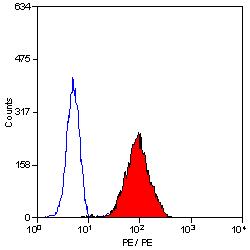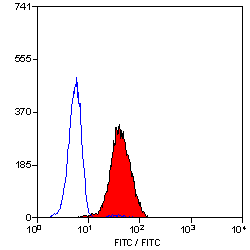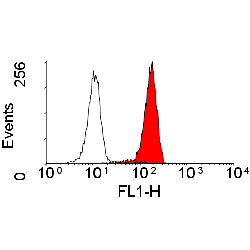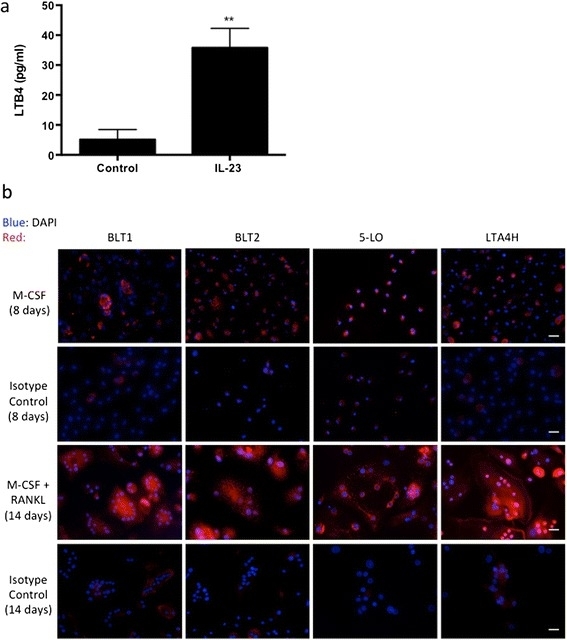BLTR antibody | 202/7B1






Mouse anti Human BLTR
- Product Type
- Monoclonal Antibody
- Clone
- 202/7B1
- Isotype
- IgG2a
- Specificity
- BLTR
| Mouse anti Human BLTR antibody, clone 202/7B1 recognizes Human leukotriene B4 receptor, also known as BLTR, Chemoattractant receptor-like 1, G-protein coupled receptor 16 or P2Y purinoceptor 7. BLTR is a 353 ~40 kDa multipass transmembrane glycoprotein BLTR is expressed by peripheral blood granulocytes and is important in the pro-inflammatory response. |
- Target Species
- Human
- Product Form
- Purified IgG - liquid
- Preparation
- MCA2108: Purified IgG prepared by affinity chromatography on Protein A from tissue culture supernatant
- MCA2108GA: Purified IgG prepared by affinity chromatography on Protein G from tissue culture supernatant
- Buffer Solution
- Phosphate buffered saline
- Preservative Stabilisers
- 0.09% sodium azide (NaN3)
- Carrier Free
- Yes
- Immunogen
- HeLa cell transfectants expressing human BLTR.
- Approx. Protein Concentrations
- IgG concentration 1.0 mg/ml
- Fusion Partners
- Spleen cells from immunised Balb/c mice were fused with cells of the mouse SP2/0 myeloma cell line.
- Regulatory
- For research purposes only
- Guarantee
- 12 months from date of despatch
Avoid repeated freezing and thawing as this may denature the antibody. Storage in frost-free freezers is not recommended.
| Application Name | Verified | Min Dilution | Max Dilution |
|---|---|---|---|
| Flow Cytometry | 1/50 Pack Size: 0.2 mg 1/100 Pack Size: 0.1 mg |
1/100 Pack Size: 0.2 mg 1/200 Pack Size: 0.1 mg |
|
| Immunoassay | |||
| Immunofluorescence | |||
| Immunohistology - Frozen |
- Flow Cytometry
- Use 10μl of the suggested working dilution to label 106 cells or 100μl whole blood
| Description | Product Code | Applications | Pack Size | List Price | Your Price | Quantity | |
|---|---|---|---|---|---|---|---|
| Mouse IgG2a Negative Control | MCA929 | F | 100 Tests |
|
Log in | ||
| List Price | Your Price | ||||||
|
|
Log in | ||||||
| Description | Mouse IgG2a Negative Control | ||||||
Source Reference
-
Pettersson, A. et al. (2000) First-generation monoclonal antibodies identifying the human leukotriene B(4) receptor-1.
Biochem Biophys Res Commun. 279 (2): 520-5.
References for BLTR antibody
-
Sabirsh, A. et al. (2005) Fluorescent leukotriene B4: potential applications.
J Lipid Res. 46: 1339-46. -
Heller, E.A. et al. (2005) Inhibition of atherogenesis in BLT1-deficient mice reveals a role for LTB4 and BLT1 in smooth muscle cell recruitment.
Circulation. 112: 578-86. -
Medoff, B.D. et al. (2005) BLT1-mediated T cell trafficking is critical for rejection and obliterative bronchiolitis after lung transplantation.
J Exp Med. 202: 97-110. -
Islam, S.A. et al. (2006) The leukotriene B4 lipid chemoattractant receptor BLT1 defines antigen-primed T cells in humans.
Blood. 107: 444-53. -
Thomas, S.Y. et al. (2007) Multiple chemokine receptors, including CCR6 and CXCR3, regulate antigen-induced T cell homing to the human asthmatic airway.
J Immunol. 179: 1901-12. -
Serezani, C.H. et al. (2009) FcgammaRI ligation leads to a complex with BLT1 in lipid rafts that enhances rat lung macrophage antimicrobial functions.
Blood. 114: 3316-24. -
Costa, M.F. et al. (2010) Leukotriene B4 mediates gammadelta T lymphocyte migration in response to diverse stimuli.
J Leukoc Biol. 87: 323-32. -
Laarman, A.J. et al. (2012) Staphylococcus aureus Staphopain A inhibits CXCR2-dependent neutrophil activation and chemotaxis.
EMBO J. 31: 3607-19.
View The Latest Product References
-
Wang, L. et al. (2012) BLT1-Dependent Alveolar Recruitment of CD4+CD25+ Foxp3+ Regulatory T Cells is Important for Resolution of Acute Lung Injury.
Am J Respir Crit Care Med.186: 989-98. -
Loell, I. et al. (2012) Activated LTB4 pathway in muscle tissue of patients with polymyositis or dermatomyositis.
Ann Rheum Dis. 72: 293-9. -
Dixit, N. et al. (2014) Leukotriene B4 activates intracellular calcium and augments human osteoclastogenesis.
Arthritis Res Ther. 16: 496. -
Sezin, T. et al. (2019) Dual inhibition of complement factor 5 and leukotriene B4 synergistically suppresses murine pemphigoid disease.
JCI Insight. 4 (15)Aug 08 [Epub ahead of print]. -
Askarian, F. et al. (2021) The lytic polysaccharide monooxygenase CbpD promotes Pseudomonas aeruginosa. virulence in systemic infection.
Nat Commun. 12 (1): 1230. -
Williams, K.M. et al. (2022) Prospective Phase II Trial of Montelukast to Treat Bronchiolitis Obliterans Syndrome after Hematopoietic Cell Transplantation and Investigation into Bronchiolitis Obliterans Syndrome Pathogenesis.
Transplant Cell Ther. S2666-6367(22)00049-5.
- Synonyms
- Leukotriene B4 Receptor
- RRID
- AB_323834
- UniProt
- Q15722
- Entrez Gene
- LTB4R
- GO Terms
- GO:0000166 nucleotide binding
- GO:0006936 muscle contraction
- GO:0005887 integral to plasma membrane
- GO:0006928 cellular component movement
- GO:0006954 inflammatory response
- GO:0006955 immune response
- GO:0007200 activation of phospholipase C activity by G-protein coupled receptor protein signaling pathway coupled to IP3 second messenger
MCA2108
MCA2108GA
If you cannot find the batch/lot you are looking for please contact our technical support team for assistance.
Please Note: All Products are "FOR RESEARCH PURPOSES ONLY"
View all Anti-Human ProductsAlways be the first to know.
When we launch new products and resources to help you achieve more in the lab.
Yes, sign me up